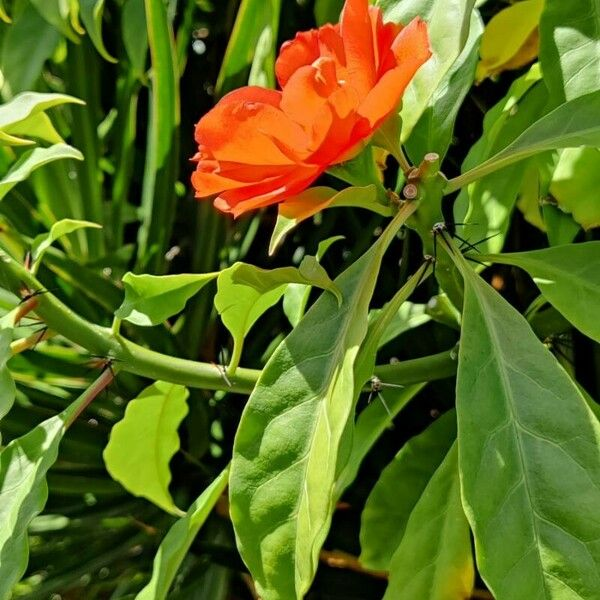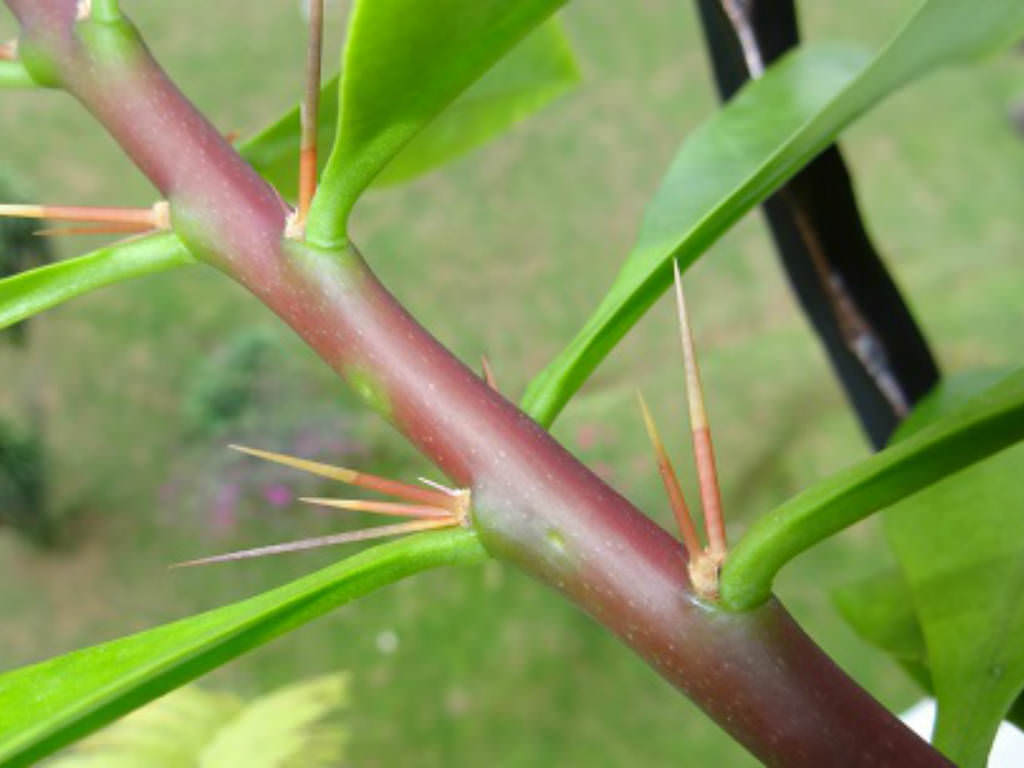HousePlantJoy is supported by our audience. When you purchase through one of our links, we may earn a small affiliate commission. As an Amazon Associate I earn from qualifying purchases. Your cost is not affected.
==================
Have you ever encountered the Pereskia Grandifolia? It’s quite a sight to behold! This stunning plant is nicknamed the Rose Cactus with its vibrant hues and delicate petals. Also known as the Rose Cactus, the Pereskia grandifolia is a unique plant that combines the look of a traditional cactus with beautiful, rose-like flowers. Owning it has been a mix of joy and challenge for me. Unlike regular cacti, it needs more care, especially when watering and finding the perfect spot with enough light.
When it blooms, it’s all worth it. The flowers are stunning, and seeing them after putting in the effort feels great. It is special as it requires extra love but truly rewards you with its beauty. Whether you’re a seasoned plant enthusiast or just starting to explore the world of flora, the Pereskia Grandifolia will surely captivate your attention and admiration.
Unlocking the Beauty: Everything You Need to Know About the Pereskia Grandifolia
Photo by: Plant Identifier
Cultivating the Rose Cactus, or Pereskia grandifolia, in my garden has been profoundly enriching. This tropical cactus variety, belonging to the Cactaceae family, is a testament to the marvels of nature. Originating from the diverse ecosystems of South America, Central America, and the West Indies, Pereskia captivates with its leafy shrub appearance, setting it apart from the typical spiky cacti often associated with the desert landscape.
The name “Pereskia” pays homage to Nicholas Claude Fabre de Peirese, a French naturalist whose contributions have significantly shaped our understanding of botany. With around twenty species under its classification, each Pereskia brings its unique beauty to the landscape, boasting vibrant flowers that echo the appearance and allure of wild roses. These blossoms, varying in shades from cream to striking red, captivate the eye and enchant the nose with their delicate fragrances.
Key Highlights
- The Rose Cactus, also recognized as Pereskia grandifolia, stands out among its cactus counterparts with its leafy shrub-like traits. Hailing from South America, Central America, and the West Indies, Pereskia thrives in habitats as diverse as its captivating appearance.
- Pereskia, a genus within the Cactaceae family, encompasses around twenty species of tropical cacti, each exhibiting distinct characteristics.
- Rose cacti exhibit distinctive traits that distinguish them from other cacti. A diverse array of species and cultivars exist within the genus Pereskia, each showcasing its spectacular flowering displays.
- The categorization of Pereskia as either a cactus or a leafy shrub has ignited discussions among botanists. Although it falls within the Cactaceae family, its leafy characteristics defy conventional perceptions of typical cacti.
- Achieving optimal growth for Pereskia Grandifolia demands precise conditions, such as partial shade to full sun exposure, well-drained soil, and safeguarding from frost. When nurtured attentively, this plant flourishes, gracing cultivators with its breathtaking allure. While Pereskia is a resilient plant, it can face some challenges in cultivation.
What Makes Pereskia Unique Among Cacti?
Photo by: World of Succulents
Rose Cacti stand out among other cacti due to their unique leafy shrub appearance. Pereskia species have persistent, non-succulent leaves, unlike most species, which have succulent stems and spiky foliage. This feature makes them the only cacti with true leaf cactus.
The leafy foliage of Pereskia provides a striking contrast to the typical image of a cactus. The leaves are simple and entire, growing from areoles and sharp spines. This combination of spines and persistent leaves is a defining characteristic of Pereskia and sets it apart from other cactus family members.
Pereskia’s leafy shrub appearance adds a lushness and vibrancy to gardens and landscapes. Its unique aesthetic value differs from most cacti’s desert-like appearance. This uniqueness makes Pereskia a sought-after greenery among gardeners and landscapers looking to create a diverse and visually appealing environment.
The Botanical Profile of Pereskia
Photo by: Cactusmania
Pereskia is a genus of tropical cacti in the Cactaceae family. The group comprises approximately twenty species, each with unique characteristics. One notable species is Pereskia grandifolia, which is known for its large leaves and vibrant blossoms.
Understanding the botanical profile of Pereskia, including its genus and species, is essential for successfully cultivating and appreciating these unique cacti.
Exploring the Distinctive Traits: Pereskia Species Unveiled
Photo by: Wikipedia
Pereskia species have distinctive characteristics that set them apart from other cacti. Here are some key features of Pereskia species, including the notable Rose Cactus:
- It is a small tree-like plant that can reach heights up to six feet.
- The leaves are broad and rounded, measuring three to six inches long and one to three inches wide.
- The flowers are showy and come in various colors, including cream, tan, gold, yellow, orange, pink, purple, lavender, and red.
- Pereskia species have sharp spines that grow from areoles and persistent, non-succulent leaves, giving them a unique appearance.
These characteristics make Pereskia species a fascinating addition to gardens and landscapes. Their vibrant blooms, lush foliage, and unique growth habits add visual interest and diversity to any planting scheme.
The Taxonomy Debate: Cactus or Leafy Shrub?
Photo by: World of Succulents
The taxonomy of Pereskia has been a subject of debate among botanists. While Pereskia belongs to the Cactaceae family, it stands out from others due to its leafy shrub appearance.
Traditionally, cacti are known for their succulent stems and spiky foliage. However, Pereskia species have persistent non-succulent leaves, making them unique within the Cactaceae family. This has led to discussions about whether Pereskia should be classified as a cactus or a leafy shrub.
The debate surrounding Pereskia’s taxonomy highlights the complexity of flora classification and the need for further research and understanding. Regardless of its classification, Pereskia’s unique characteristics and ornamental value make it a fascinating and sought-after plant among gardeners and enthusiasts.
Pereskia Varieties and Their Blooming Wonders
Pereskia offers a variety of species and cultivars, each with its unique blooming wonders. Here are some notable Pereskia varieties and their characteristics:
- Pereskia grandifolia (Var. Rosea): This variety features dense inflorescences of large, purplish-pink double rose-like flowers with yellow stamens. It was later called rose cactus. It blooms in summer and can be a showstopper in any garden or landscape.
- Pereskia aculeata (Var. Godseffiana): This variety is known for its dense clusters of bright yellow petals that appear in late spring or early summer.
- Pereskia bleo: This variety boasts clusters of pink to purple petals with a sweet fragrance. It blooms profusely and adds a touch of elegance to gardens and landscapes.
Cultivating Pereskia: Best Practices
Photo by: Cactus-art-biz
Cultivating Rose Cactus requires specific conditions and best practices to ensure its growth and health. Here’s the lowdown:
- Propagation: Pereskia can be propagated from seeds or fresh stem cuttings planted in well-draining soil or water.
- Light: Pereskia thrives in partial shade to full sun. It can tolerate direct sunlight but may require protection in intense heat.
- Watering: Pereskia prefers regular watering but should be allowed to dry out between waterings. Be cautious not to water excessively, as it may result in root rot.
- Soil: Pereskia’s flourishing hinges on well-drained soil. A potting soil blend and perlite can effectively promote adequate drainage, fostering healthy development.
- Temperature: Pereskia is sensitive to cold temperatures and should be protected from frost.
- Humidity: Pereskia thrives in environments with moderate humidity. If you reside in a dry region, consider misting the leaves or employing a humidifier to maintain optimal moisture levels.
Common Challenges and Solutions in Pereskia Cultivation
While Rose Cactus is a resilient plant, it can face some challenges in cultivation. Here’s the lowdown:
- Pests: Pereskia can be susceptible to common garden pests, such as aphids and mealybugs. Consistently checking and treating with organic insecticides or insecticidal soaps can effectively prevent pest infestations.
- Drought: Pereskia requires regular watering, but it should not be overwatered. Adhering to appropriate watering techniques, like allowing the soil to dry between waterings adequately, can mitigate the risk of drought stress.
- Cold Hardiness: Pereskia is not frost-tolerant and should be protected from freezing temperatures.
Historical and Cultural Significance
- Medicinal Use: Pereskia Grandifolia holds historical and cultural importance in regions where it grows. Indigenous communities have valued it for its medicinal properties, utilizing various parts for remedies. Throughout history, indigenous healers have incorporated Pereskia Grandifolia into their traditional medicine practices to address a range of ailments, from digestive issues to skin conditions.
- Symbolism in Folklore and Mythology: Additionally, Pereskia Grandifolia features prominently in folklore and mythology, symbolizing resilience and beauty. Stories and legends intertwine with the plant’s existence, enriching its cultural significance. It is often associated with tales of strength, endurance, and the interconnectedness of nature, reflecting the deep-rooted beliefs and values of indigenous cultures.
- Contemporary Cultural Celebrations: Today, Pereskia Grandifolia continues to be celebrated in cultural events and rituals, serving as a reminder of our connection to nature and ancestral knowledge. Its presence in gardens and landscapes not only adds aesthetic value but also carries with it layers of cultural heritage and tradition. Communities honor the plant’s significance through festivals, ceremonies, and the preservation of traditional knowledge surrounding its cultivation and use.
Exploring the historical and cultural significance of Pereskia Grandifolia adds depth to our understanding of this botanical marvel, shedding light on its multifaceted role beyond its ornamental value.
Enduring Allure of Pereskia Grandifolia
The Pereskia grandifolia, fondly nicknamed the Rose Cactus, is a botanical wonder that enchants the senses with its vivid colors and fragile petals. While cultivating this beauty may present challenges, the effort is rewarded manifold when it blooms in all its splendor. Its unique leafy shrub appearance and showy rose-like flowers set it apart from the traditional cactus image, adding a lushness and vibrancy to any garden or landscape. The taxonomic debate surrounding Pereskia’s classification underscores its uniqueness within the Cactaceae family, further highlighting its botanical intrigue. Whether classified as a cactus or a leafy shrub, there’s no denying the ornamental value and allure of Pereskia species.
With proper care and cultivation practices, Pereskia can thrive, offering a spectacle of blossoms and foliage that enchants seasoned gardeners and novices alike. So, if you ever have the chance to encounter Pereskia grandifolia, seize the opportunity to unlock its beauty and enrich your botanical journey.
Are you intrigued by the captivating beauty of the Pereskia Grandifolia? Are you ready to embark on your botanical adventure? Visit Houseplant Joy’s website today to explore a diverse selection of plants, including rare gems like the Rose Cactus.
Frequently Asked Questions
Is Pereskia Suitable for Indoor Gardening?
Pereskia can be grown indoors, but it requires bright light to thrive. For optimal lighting, position it near a south-facing window or place it under grow lights to guarantee it gets ample light. Regular care, including watering, pruning, and fertilizing, is necessary to maintain health and appearance.
Is Pereskia Grandifolia Edible?
Yes, Pereskia Grandifolia produces edible fruit. While its aesthetic beauty often steals the spotlight, the fruit of this cactus is also noteworthy. The fruits are known for their sweet and tangy flavor, making them a delicacy in certain cultures where they are consumed fresh or used in culinary preparations.
Is Pereskia Grandifolia the Only Species of Its Kind?
Pereskia Grandifolia is just one species within the group of Pereskia, which comprises around 17 known species.
Get Ready to Plant Yourself in a World of Wonder!
Hey plant pals! Ready to dive into the lush life with Houseplant Joy?
Follow us on socials for a jungle of awesome content, honest reviews, and a community that’s all about nurturing those leafy buddies!
Facebook: Let’s Connect on Facebook
Instagram: Catch Us on Insta
Pinterest: Pin Your Plant Dreams
Twitter: Tweet Us!
YouTube: PlantTube Fun Awaits
TikTok: TikTok and Plant Talk
Don’t miss out on the green goodness! Let’s sprout some joy together!













